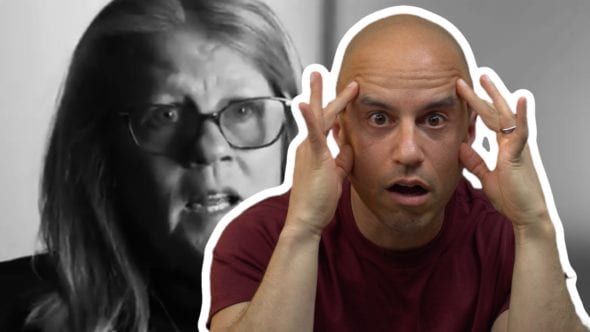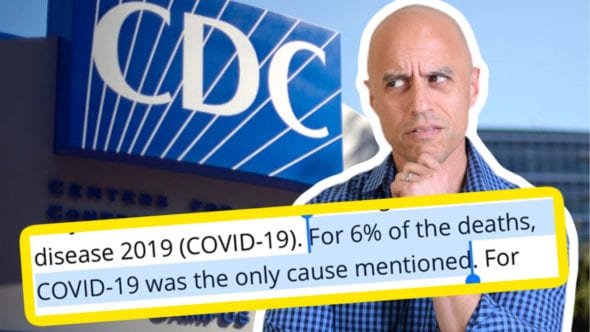Get the feeling that you’re LESS productive when video is involved? New science says you’re right.
Full Transcript Below
So ever since the pandemic there’s been this big push to do video conferencing, whether at Zoom or Skype or whatever, everybody thinks that, you know, we can lessen risk by keeping people apart, but then have all the benefits of them collaborating together in groups to solve problems at work, by using video audio conferencing. So, the video component would mimic being in person with people and the audio component as well, right? As opposed to just a telephone call or a conference, you know, conference telephone line, something like that. But there’s no data, previously, that says that that actually works.
Well now there’s data coming out of Carnegie Mellon and Santa Barbara, these collaborators from a business school in Santa Barbara researchers, showing that it’s actually worse to use video conferencing for group collaboration. So let me walk you through what happened here. And it tells you something really important about not just the pandemic, but what we’re going to do afterwards. So, they took groups of about 200 people, they split them into pairs. So you’ve got a hundred pairs. And they took those pairs and split them into two groups. So 50 of the pairs were able to get on a phone conversation basically, so like a Zoom chat without video, and the other 50 pairs collaborated via a full audio video conference call.
And they were assigned certain tasks to solve. Now, there is a thing called collective intelligence, which measures how well a group of humans can coordinate together to solve problems. And let’s be quite clear, what separates humans from other animals that we understand, the reason we dominate the planet is not necessarily that we’re the smartest. So dolphins are really smart, certain primates have high intelligence, freaking crows can use tools. It’s that humans are able to collaborate flexibly in large groups that they don’t know to solve problems. And we use language, both verbal and visual cues to do that.
So, this is a uniquely human thing that has allowed us to basically overrun the planet, and collective intelligence is how we get there. Now order to do that.. And by the way, this is very different, than say, a beehive’s collective intelligence. Cause you could say, “Well, oh, there are lots of social, even insects, that behave very as a group quite intelligently.” Yeah. The difference is they are not flexible. So a drone bee, a worker bee is a worker bee. It can’t suddenly decide to do a different project or, you know, do a little bit of the work of the queen for a while. Turns out humans can do that.
They can do it flexibly and they’re not genetically related, like the beehive. That’s remarkable. Now, what the researchers did is they then took these two groups, group that just had audio, and the group that had audio visual, and they measured their performance on a series of like six tasks that require collective intelligence. And what they found was that the group that had access to video did worse. Now, in order to understand why that might be.. Now first of all, intuitively, does this feel right to you? People who’ve been on zoom for the last year. Do you hate video as much as I do?
So, in order to understand these results, you gotta understand a couple, little bit of terminology. Okay? There are a couple ways that researchers think that humans develop collective intelligence. And, the key piece of it is that they need to synchronize their communications. The way they do that is they synchronize their cues as to when they are supposed to speak. They do that partially through visual recognition, like eye contact, different body language, nonverbal cues, right? Like when I say, if you see me lean into like, “Ah, ah, ah.” Then I wanna say something. I want a turn. And the way you wanna synchronize around requesting a turn to speak, yielding your turn to speak, and maintaining your turn to speak.
So, you can do it non-verbal like that, visual cues, or, and or, you can do it with audio cues. So, changes in tone, changes in volume, how much you emphasize, do you kind of trail off and stop speaking and then combine it with a little visual cue? Those are all signs that you’re yielding, right? And then you can hear other people like kind of but in verbally, “But, but but, aah.” You hear those kinds of things, right? In a real life conversation. That’s how we collaborate in person. Well, turns out what the.. And so, the verbal component of that is called prosodic communication. P-R-O-S-O-D-I-C. Prosodic communication. And then the visual stuff is visual.
So, what the researchers determined, they think the theory is, when we have video in a video conference, you’re used, you’re trying to rely on these visual cues, like eye contact and so on, and in video conferencing, the cues are different. We behave differently. We’re looking at our own image. We’re trying to constantly be on. The eye contact is a little bit off. Cause you’re looking at your camera. Everything’s just a little bit off, and you’re not taking the whole picture, you’re just getting this much or whatever the person’s showing. So you’re missing some body language stuff, and it’s low bandwidth, so it’s a little creaky. And so people are able to dominate conversations using those visual cues, in a way that wouldn’t naturally happen in person. And so, the visual aspect of it is actually detracting from prosodic synchronization. In other words, synchronization based on audio cues. The visual is dominating in a way that’s counterproductive.
Because in the people who were just having audio, prosodic synchronization chats, they were able to share their speaking turns much more equally than the video group. And the suspicion is, and I think I agree with this, how many times have you had a video chat where you’re just so like having to be on in terms of facial expressions, connecting, looking, staring, what’s my eye contact, what do I look like? Looking at your own image, then trying to listen, and trying to decide when you’re supposed to jump in. It’s almost impossible to get it right. Whereas turn off the video, listen. You’re there in a flow pocket with that other person, Cueing only on their auditory prosodic synchrony cues. And then you share the conversations much more flowing, especially if there’s no lag.
The minute you introduce lag, all bets are off. Because you talk over each other, it becomes this whole, “Oh wait, no, you go. Oh no you go. Oh and you go.” That is a poison for collaboration, a poison for free flow of communication, and for prosodic synchronization that leads to collective intelligence. So with a good high bandwidth connection devoted just to audio. So you lose some of that delay. They did better. I buy it. I hate video conferencing except to quickly see you’re talking to, to get a sense if there’s something visual you need to do, like looking at slides, fine. Otherwise, especially if there’s more than one person, it is a eye poke, and it’s less productive. And it’s so tiring, because you have to be constantly trying to artificially recognize these cues. So here’s the call to action.
It’s simple as this, if you’re trying to get more efficient, start the Zoom call with video, say hi to everyone, then turn your damn video off, and keep it off for the conversation. Put in some headphones so you can hear carefully or whatever it is, and focus on that. And you’ll just be happier, more productive, less zoom fatigue. It’s like the old school telephone calls. And that’s why it has ramifications for telehealth. A lot of our patients don’t want the video aspect, except if they need it, they’re showing a rash or they’re introducing themselves to a doctor to make a relationship, then you can go to audio only, and it’s probably more effective for a lot of stuff. Okay? If you like this kind of show become a supporter, zdoggmd.com/supporters. Just share it. Leave your comments of what you think about video conferencing below, and if you’ve had the opposite effect. Some people who are severe introverts do better on video. Share the thing and we are out. Turn that video off snitches. Peace.
Category
- The ZDoggMD Show (818)
- Featured Videos (189)
- Doc Vader (142)
- Against Medical Advice (128)
- Medical Humor (95)
- Public Service Announcements (87)
- Music Parodies (74)
- Nurses (59)
- Meditation (46)
- The VPZD Show (38)
- ZVlogg (36)
- ZTalks (28)
- ZBlogg (24)








